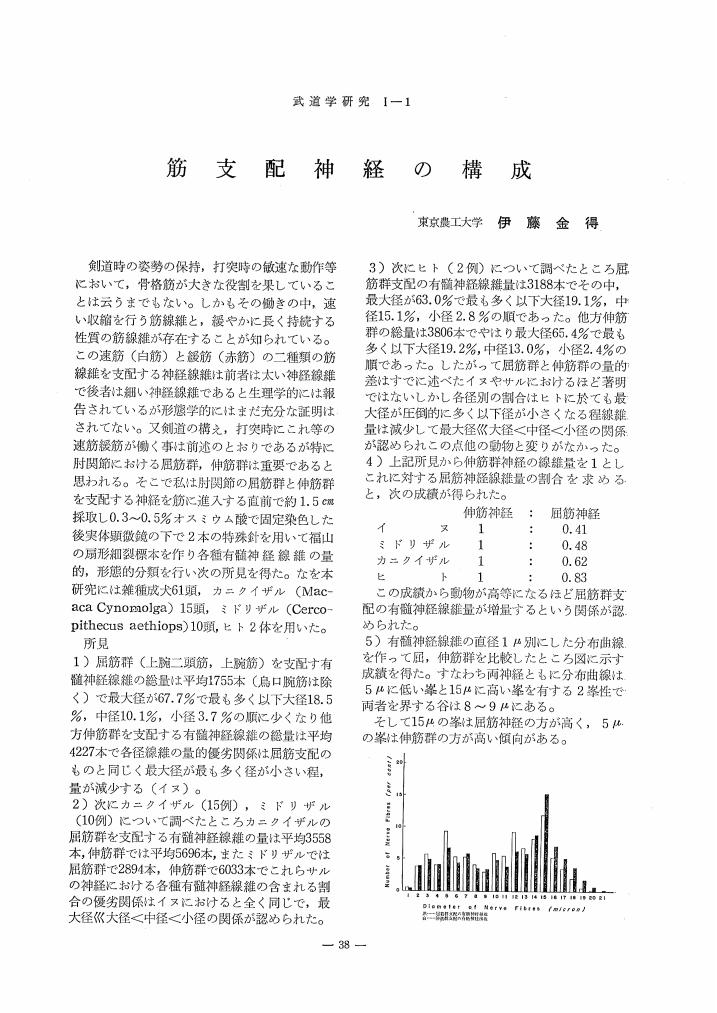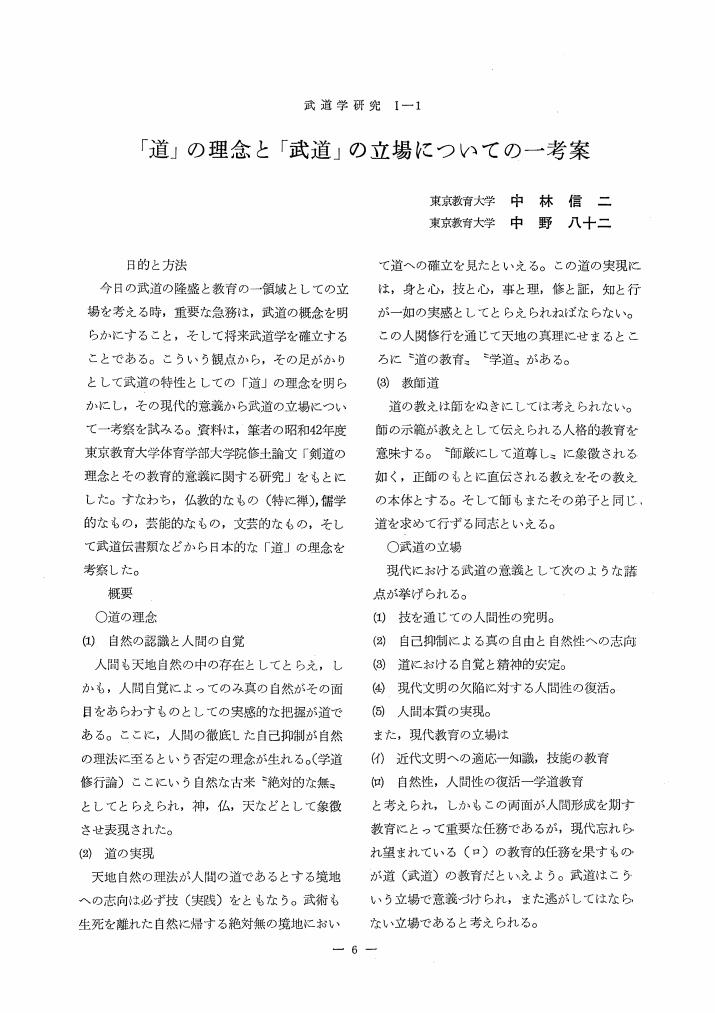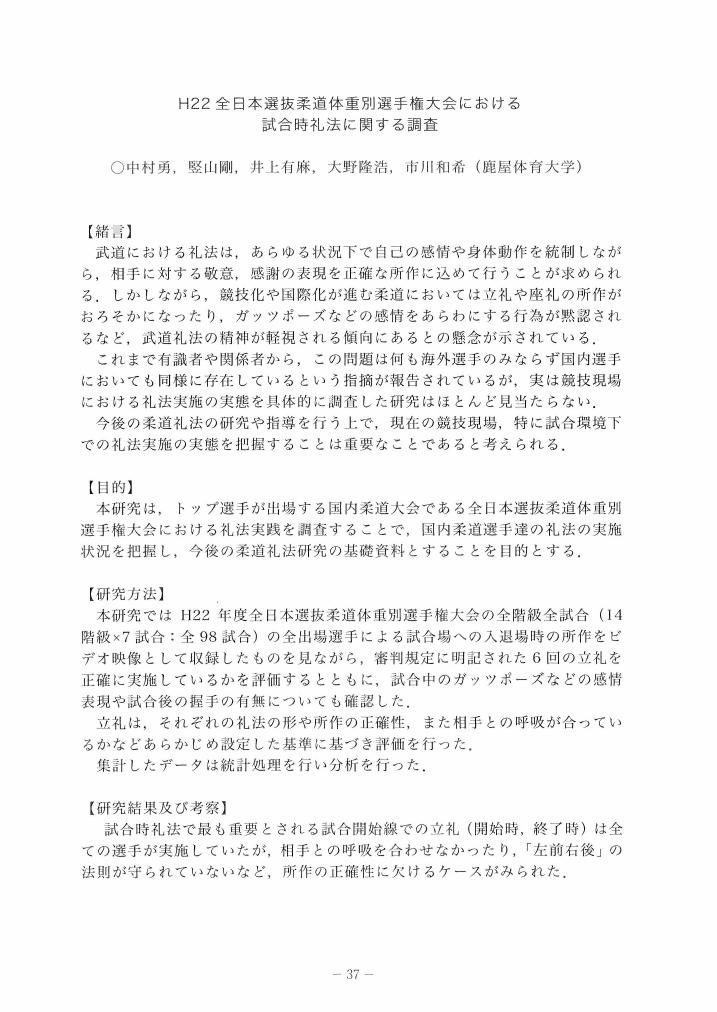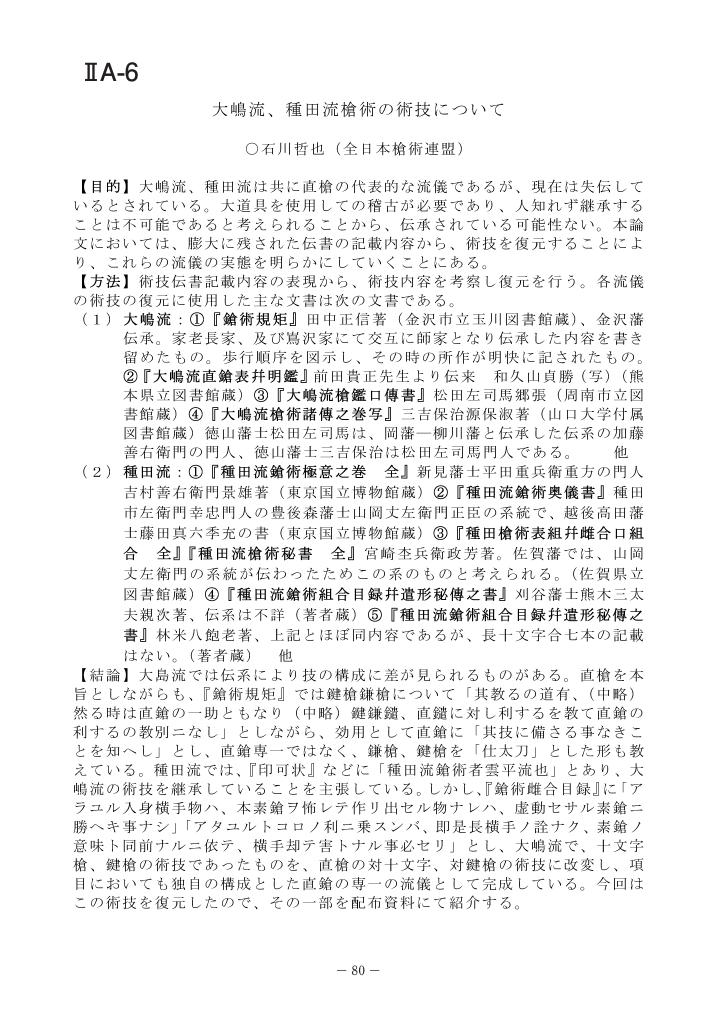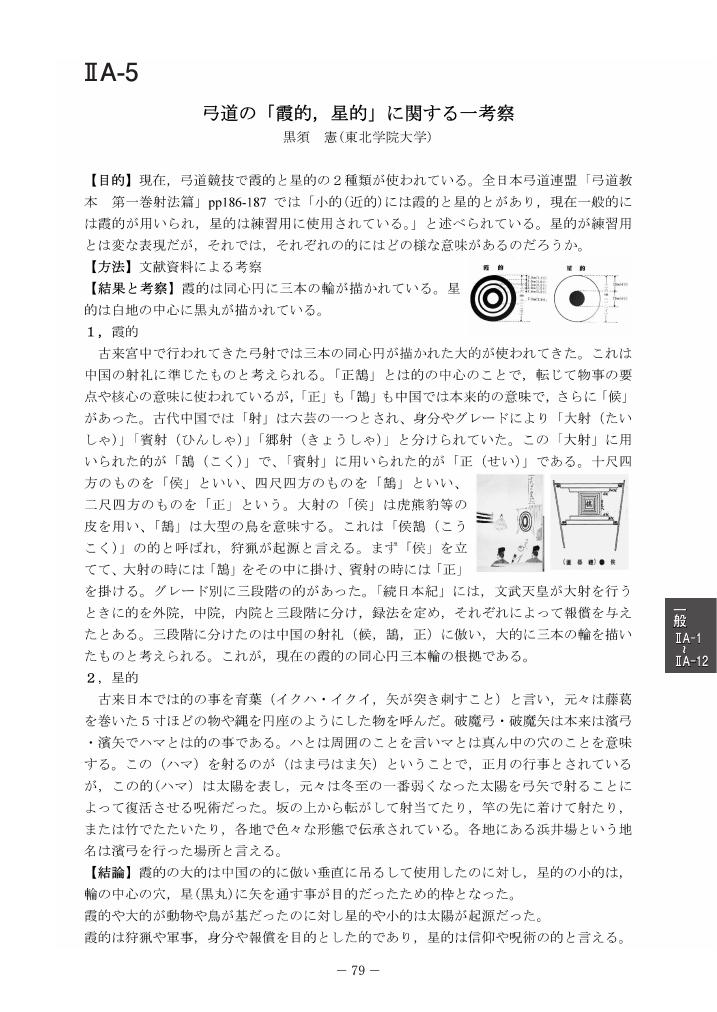2 0 0 0 OA 幕末における剣術廻国修行について(延岡藩鈴木栄の日記を中心に)
- 著者
- 老松 信一
- 出版者
- 日本武道学会
- 雑誌
- 武道学研究 (ISSN:02879700)
- 巻号頁・発行日
- vol.1, no.1, pp.22, 1968-12-25 (Released:2012-11-27)
2 0 0 0 OA 柔道投げ技の類型的研究
2 0 0 0 OA 筋支配神経の構成
- 著者
- 伊藤 金得
- 出版者
- 日本武道学会
- 雑誌
- 武道学研究 (ISSN:02879700)
- 巻号頁・発行日
- vol.1, no.1, pp.38, 1968-12-25 (Released:2012-11-27)
2 0 0 0 OA 柳生新陰流の研修,指導に就いて
- 著者
- 大坪 指方
- 出版者
- 日本武道学会
- 雑誌
- 武道学研究 (ISSN:02879700)
- 巻号頁・発行日
- vol.1, no.1, pp.15, 1968-12-25 (Released:2012-11-27)
2 0 0 0 OA 「剣道の基本打撃動作分析に関する一考察」
- 著者
- 平川 信夫 坪井 三郎
- 出版者
- 日本武道学会
- 雑誌
- 武道学研究 (ISSN:02879700)
- 巻号頁・発行日
- vol.1, no.1, pp.32, 1968-12-25 (Released:2012-11-27)
2 0 0 0 OA 「しない」の長さについての一考察
- 著者
- 山根 幸恵
- 出版者
- 日本武道学会
- 雑誌
- 武道学研究 (ISSN:02879700)
- 巻号頁・発行日
- vol.1, no.1, pp.14, 1968-12-25 (Released:2012-11-27)
2 0 0 0 OA 「道」の理念と「武道」の立場についての一考案
- 著者
- 中林 信二 中野 八十二
- 出版者
- 日本武道学会
- 雑誌
- 武道学研究 (ISSN:02879700)
- 巻号頁・発行日
- vol.1, no.1, pp.6, 1968-12-25 (Released:2012-11-27)
2 0 0 0 OA H22全日本選抜柔道体重別選手権大会における試合時礼法に関する調査
2 0 0 0 OA 弓道における大三についての考察
- 著者
- 松尾 牧則
- 出版者
- 日本武道学会
- 雑誌
- 武道学研究 (ISSN:02879700)
- 巻号頁・発行日
- vol.31, no.Supplement, pp.66, 1998 (Released:2012-11-27)
2 0 0 0 OA 文部省の学校武道指導指針の史的展開過程(一)―学校剣道にみる価値志向の変遷について―
- 著者
- 田中 鎮雄
- 出版者
- 日本武道学会
- 雑誌
- 武道学研究 (ISSN:02879700)
- 巻号頁・発行日
- vol.13, no.3, pp.19-27, 1981-03-31 (Released:2012-11-27)
- 参考文献数
- 14
Change of value orientation about KENDO in the Course of Study for Secondary Schools and its manuals were investigated in Japan from 1913. The results were as follows:(1) The modern Japanese school KENDO was founded in 1911 at the end of the Meiji Era. At the beginning of that time, KENDO was involved in the options program and not involved in the Teaching Handbook.(2) The aims and contents of KENDO in the secondary schools were determined by the Ministry of Education and fully described in the Course of Study in 1936. At that time, the most important aims of KENDO was spiritual training for young people in school and its community.(3) Though KENDO and JUDO have gradually developed, as well as gymnastics and military drill in physical education program, they were regarded as more and more important at that time of the World War I and II. And at last, the spiritual and military training in KENDO, as well as other physical education program had stressed as the greatest of value orientations at that time of the War II.(4) Afer the War II, from 1953, the aims and contents of KENDO in the secondary schools have gradually developed as sport.(5) On the other hand, there seems to be no doubt that KENDO has left some value concerning the spiritual and physical training.
2 0 0 0 OA 広島藩の貫心流に関する研究
- 著者
- 森本 邦生
- 出版者
- 日本武道学会
- 雑誌
- 武道学研究 (ISSN:02879700)
- 巻号頁・発行日
- vol.34, no.Supplement, pp.6a-6a, 2001 (Released:2012-11-27)
2 0 0 0 OA 大嶋流、種田流槍術の術技について
- 著者
- 石川 哲也
- 出版者
- 日本武道学会
- 雑誌
- 武道学研究 (ISSN:02879700)
- 巻号頁・発行日
- vol.49, no.Supplement, pp.S_80, 2016 (Released:2018-03-12)
2 0 0 0 OA 武芸における「瞑想」についての一考察 ―心身論的視点からの序説として―
- 著者
- 前林 清和 中林 信二
- 出版者
- 日本武道学会
- 雑誌
- 武道学研究 (ISSN:02879700)
- 巻号頁・発行日
- vol.18, no.3, pp.6-15, 1986-02-28 (Released:2012-11-27)
- 参考文献数
- 46
From ancient times, Meiso (meditation) has shaped the core of the ascetic exercises, “Syugyo” in case of orientalism. Meiso (meditation) has also been introduced into the process of “Syugyo” by Japanese military arts. So, this study intended to classify the concept of Meiso (meditation) and to investigate what Meiso (meditation) in the military arts had been.Summaries are as follows;(1) Meiso (meditation) is the method to experience a state of unconsciousness above consciousness, and to unify both.(2) According to the psychological point of view, Meiso (meditation) has two aspects; the one is accompanied with active image (for example Yoga) the other is not (Za-Zen). The former refuses external stimuli, the latter is openminded and then keeps awaking situation.(3) From the physical viewpoint has static manner (Za-Zen) and active ones (Kinhin, Jogyozanmai).(4) Statical meditation in the military arts has been used in order to extinguish worldly thoughts and get to the higher state of mind.(5) Performing the practice the military arts, Keiko (Kata) itself can be explained as active meditation with physical exercise, that has made much of the respiratory method. That state of mind is similar to that of Zen.
- 著者
- 中嶋 哲也 立木 幸敏
- 出版者
- 日本武道学会
- 雑誌
- 武道学研究 (ISSN:02879700)
- 巻号頁・発行日
- vol.49, no.Supplement, pp.S_30, 2016 (Released:2018-03-12)
2 0 0 0 OA 武道生活45年の回顧 ―嘉納先生の柔道観―
- 著者
- 望月 稔 村井 恭一
- 出版者
- 日本武道学会
- 雑誌
- 武道学研究 (ISSN:02879700)
- 巻号頁・発行日
- vol.6, no.1, pp.42-43, 1973-09-23 (Released:2012-11-27)
2 0 0 0 OA 弓道の「霞的,星的」に関する一考察
- 著者
- 黒須 憲
- 出版者
- 日本武道学会
- 雑誌
- 武道学研究 (ISSN:02879700)
- 巻号頁・発行日
- vol.49, no.Supplement, pp.S_79, 2016 (Released:2018-03-12)
2 0 0 0 OA 弓道の操作イメージと実運動の比較検討:道具の運動から予期する上肢の構えに着目して
- 著者
- 木村 陽子
- 出版者
- 日本武道学会
- 雑誌
- 武道学研究 (ISSN:02879700)
- 巻号頁・発行日
- vol.51, no.2, pp.101-111, 2018-12-28 (Released:2019-12-28)
- 参考文献数
- 28
This study presents the differences in arm positions between the handling images and the actual movements of kyudo practitioners. Arm positions were established as left hand pressure and as the angle of the left elbow and hand.Regarding handling images, interviews were conducted separately about the hand-pressure ratio, the angle of the elbow and hand, and the sequence of movements. The targeted movements included the tenouchi i of expert and intermediate practitioners. With respect to the sequence of movements, the focus was on hanareii.The following results were obtained:1. Hand-pressure ratio showed no differences between handling images and actual movements for both expert and intermediate practitioners.2. For experts, when the arrow was released from the string, hand pressure increased but showed no differences between handling images and actual movements. However, it decreased and differences between them were apparent for intermediate practitioners.3. All skill levels moved so that the timing was faster for the angle of the elbow and hand than for hand-pressure. For experts, these angles moved in the same direction, but for intermediate practitioners, the angles moved in the reverse direction.4. Even when there were no handling images, differences sometimes arose between expert and intermediate practitioners.These characteristics evaluate the movements of both expert and intermediate practitioners, and in the future this study will be useful for teaching and learning kyudo.i Tenouchi: An important skill in tekichu (hitting the target)ii Hanare: The movement of the release of the hand or the arrow from the string
2 0 0 0 OA 柔道選手における運動間に行う短時間の前腕筋群へのアイシングが把持筋持久力に及ぼす影響
- 著者
- 志々目 由理江 藤田 英二
- 出版者
- 日本武道学会
- 雑誌
- 武道学研究 (ISSN:02879700)
- 巻号頁・発行日
- pp.2103, (Released:2021-07-07)
- 参考文献数
- 35
The aim of this study is to investigate the effect of short-term icing of the forearm muscle group between exercises on the grip endurance of judo athletes. The participants were eight female university judo athletes (mean age: 21.3±3.1 years). Grip endurance was evaluated through an exercise task by attaching weighted “Uchi Komi Straps” to the forearms of the judo athletes, and then measuring the gripping time (all-out time). The exercise task was performed twice with a 5-minute rest period between the two sets. During the rest period, four intervention conditions were performed: icing, stretching, icing and stretching, and rest only (control). In addition to measuring the all-out time during the exercise task, maximum grip strength, rate of force development during gripping, skin temperature of the forearm, and subjective feeling of fatigue in the forearm were also measured before and after the tasks. Blood flow through the flexor muscle group of the forearm after the intervention was also measured and compared with the blood flow at rest. The results revealed a reciprocal action in the all-out time during the two sets of the exercise task, and in the second exercise task the two conditions that included icing significantly suppressed the all-out time reduction compared to the control condition. While there were no significant interactions between the four conditions and maximum grip strength, the rate of force development during gripping was not adversely affected by icing. There were no significant differences in the blood flow of the forearm flexor muscle group among the different intervention conditions. These results suggest that it may be possible to prevent a reduction in the grip endurance of judo athletes by icing the forearm muscles for a short period of time between exercises or by using a combination of stretching and a short period of icing.
2 0 0 0 OA 剣道専門分科会企画 講演会 剣道とマスメディア:テレビ放送からみた剣道
2 0 0 0 OA 近世武芸における「呼吸」と「気」の諸問題
- 著者
- 前林 清和
- 出版者
- 日本武道学会
- 雑誌
- 武道学研究 (ISSN:02879700)
- 巻号頁・発行日
- vol.20, no.1, pp.51-61, 1987-07-31 (Released:2012-11-27)
- 参考文献数
- 54
In recent years, they are calling the contradiction of the Cartesian mind-body dualism in question in the West. And scholars in various circles are re-examining heartily the mind-body problem in order to find a way out of the mental and social unrest. They are taking special notice of the traditional patterns of thinking in the East, because there is a strong tendency in the Eastern theories of the body to grasp the mind and body as an inseparable unity. So, this study intended to relate “ki” with “breath”, considered to be central issue in the Eastern theories about the body, in the military arts of Japan. Summaries are as follows; 1. “BREATH” was thought of coming and going of “ki” in the military arts. And the relationship between the cosmos and the human beings has been discussed as the correspondence between the macro-cosmos and the micro-cosmos (cosmology). This tought originated in China (Confucianism).2. “Breath” in the military arts has been used in order to control “ki”, to get to a higher state of mind and to improve ability of the body. x 3. In the match, “breath” was one of the ways of making “ma” (timing, rhythm, pace) between the player and his opponent. And in the case of a higher rank, an expert could control his opponent by using only “ki”.


